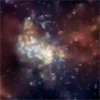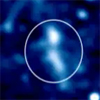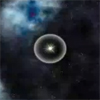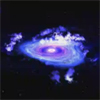CXC Home | Search | Help | Image Use Policy | Latest Images | Privacy | Accessibility | Glossary | Q&A
Images of Light Echo at Galactic Center
Quicktime MPEG
This sequence shows the location of the light echo at the Galactic Center by placing it in context with other Chandra observations of the region. The light echo is produced when X-rays from the Milky Way's giant black hole bounce off surrounding gas clouds. The light echo is found approximately 50 light years away from Sagittarius A* (or Sgr A*, for short), the supermassive black hole in the Galactic Center.
[Runtime: 0:25]
(Credit: NASA/CXC)
Quicktime MPEG
This sequence shows the location of the light echo at the Galactic Center by placing it in context with other Chandra observations of the region. The light echo is produced when X-rays from the Milky Way's giant black hole bounce off surrounding gas clouds. The light echo is found approximately 50 light years away from Sagittarius A* (or Sgr A*, for short), the supermassive black hole in the Galactic Center.
[Runtime: 0:25]
(Credit: NASA/CXC)
Variability in Chandra Images of Light Echo
Quicktime MPEG
The first image shows Chandra data of the middle of the Milky Way, with the position of Sgr A* labeled. The view then shows how the X-ray emission in the gas clouds change in shape and brightness between the three different observations in 2002, 2004 and 2005. This behavior agrees with theoretical predictions for a light echo produced by Sgr A* and helps rule out other interpretations.
[Runtime: 0:22]
(Credit: NASA/CXC/Caltech/M.Muno et al.)
Quicktime MPEG
The first image shows Chandra data of the middle of the Milky Way, with the position of Sgr A* labeled. The view then shows how the X-ray emission in the gas clouds change in shape and brightness between the three different observations in 2002, 2004 and 2005. This behavior agrees with theoretical predictions for a light echo produced by Sgr A* and helps rule out other interpretations.
[Runtime: 0:22]
(Credit: NASA/CXC/Caltech/M.Muno et al.)
Illustrations of Light Echo
Quicktime MPEG
This sequence of illustrations shows how an outburst from Sgr A* -- produced when material falls into the black hole -- generates a light echo. The faint, star-like object in the center represents the typical, quiet behavior, when the black hole does not have much material to consume. When the black hole's feeding rate increases dramatically, the material around Sgr A* brightens. Although the black hole outburst stops, the light from the outburst continues to travel outwards and then reflects, or echoes, off three clouds of gas in its path.
[Runtime: 0:13]
(Credit: NASA/CXC/M.Weiss)
Quicktime MPEG
This sequence of illustrations shows how an outburst from Sgr A* -- produced when material falls into the black hole -- generates a light echo. The faint, star-like object in the center represents the typical, quiet behavior, when the black hole does not have much material to consume. When the black hole's feeding rate increases dramatically, the material around Sgr A* brightens. Although the black hole outburst stops, the light from the outburst continues to travel outwards and then reflects, or echoes, off three clouds of gas in its path.
[Runtime: 0:13]
(Credit: NASA/CXC/M.Weiss)
Animation of a Black Hole's Outburst
Quicktime MPEG
This animation shows how high-energy particles and X-ray flares are produced when matter falls onto the accretion disk around a supermassive black hole. Astronomers believe such an event occurred to produce the light echo seen in the latest Chandra results.
[Runtime: 0:10]
(Credit: NASA/CXC/D.Berry)
Quicktime MPEG
This animation shows how high-energy particles and X-ray flares are produced when matter falls onto the accretion disk around a supermassive black hole. Astronomers believe such an event occurred to produce the light echo seen in the latest Chandra results.
[Runtime: 0:10]
(Credit: NASA/CXC/D.Berry)
Return to Light Echo at Galactic Center (10 Jan 07)






